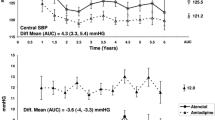Summary
Results from the HOPE and EUROPA trials showed that ACE inhibitors lower cardiovascular mortality of patients with atherosclerosis and preserved left ventricular function. However, despite apparently adequate study design, the recently conducted PEACE trial detected no benefit of an additional ACE inhibitor treatment in patients with coronary artery disease and no heart failure with respect to cardiovascular risk reduction. One of the main reasons for this discrepancy might be the lower cardiovascular baseline risk of the PEACE study population, which was more intensively treated with lipid lowering drugs and myocardial revascularization prior to enrollment than patients in HOPE or EUROPA. Another reason for the negative results of PEACE might be substance-specific differences between individual ACE inhibitors (trandolapril in PEACE, ramipril in HOPE, and perindopril in EUROPA) in their clinical efficacy to reduce cardiovascular end-points. The PEACE trial did not achieve the originally projected sample size and the addition of a soft end-point of revascularization has not been helpful. While the results from the PEACE trial suggest that low-risk patients with coronary artery disease and with preserved left ventricular function who receive intensive standard therapy including lipid lowering and coronary revascularization may not benefit from additional ACE inhibition therapy, this conclusion should be made with caution. A number of reasons, other than drug treatment efficacy, may explain the neutral results in the PEACE trial. Further studies are needed to try to resolve this issue. In the meantime, the overwhelming data still support the use of ACE inhibitors in patients with coronary artery disease with preserved left ventricular function.
Similar content being viewed by others

References
The CONSENSUS Trial Study Group (1987) Effects of enalapril on mortality in severe congestive heart failure: results of the Cooperative North Scandinavian Enalapril Survival Study (CONSENSUS). N Engl J Med 316:1429–1435
The SOLVD Investigators (1991) Effect of enalapril on survival in patients with reduced left ventricular ejection fractions and congestive heart failure. N Engl J Med 325:293– 302
The SOLVD Investigators (1992) Effect of enalapril on mortality and the development of heart failure in asymptomatic patients with reduced left ventricular ejection fractions. N Engl J Med 327:685–691
The Acute Infarction Ramipril Efficacy (AIRE) Study Investigators (1993) Effect of ramipril on mortality and morbidity of survivors of acute myocardial infarction with clinical evidence of heart failure. Lancet 342: 821–828
Dickstein K, Kjekshus J, and the OPTIMAAL Steering Committee, for the OPTIMAAL Study Group (2002) Effects of losartan and captopril on mortality and morbidity in high-risk patients after acute myocardial infarction: the OPTIMAAL randomised trial. Lancet 360:752–760
The Heart Outcomes Prevention Evaluation Study Investigators (2000) Effects of an angiotensin-converting-enzyme inhibitor, ramipril, on cardiovascular events in high-risk patients. N Engl J Med 342:145–153
Fox KM. The EURopean trial on reduction of cardiac events with Perindopril in stable coronary Artery disease Investigators (2003) Efficacy of perindopril in reduction of cardiovascular events among patients with stable coronary artery disease: randomised, double-blind, placebo-controlled, multicentre rial (the EUROPA study). Lancet 362:782–788
Gibbons RJ, Abrams J, Chatterjee K, Daley J, Deedwania PC, Douglas JS, Ferguson B, Fihn SD, Fraker TD, Gardin JM, O’Rourke RA, Pasternak RC, Williams SV (2003) ACC/AHA 2002 guideline update for the management of patients with chronic stable angina – summary article. Circulation 107:149–158
The PEACE Trial Investigators (2004) Angiotensin-converting-enzyme inhibition in stable coronary artery disease. N Engl J Med 351:2058–2068
Mancini GB, Henry GC, Macaya C et al (1996) Angiotensin-converting enzyme inhibition with quinapril improves endothelial vasomotor dysfunction in patients with coronary artery disease. Circulation 94:258–265
Anderson RN, Smith BL (2003) Deaths: leading causes for 2001. Natl Vital Stat Rep 52:1–86
Yusuf S (2005) ACE inhibition in stable coronary artery disease [corresponence]. N Engl J Med 352:937– 939
Pilote L, Abrahamowicz M, Rodrigues E, Eisenberg MJ, Rahme E (2004) Mortality rates in elderly patients who take different angiotensin-converting enzyme inhibitors after acute myocardial infarction: a class effect? Ann Intern Med 141:102–112
Brown NJ, Vaughan DE (1998) Angiotensin- converting enzyme inhibitors. Circulation 97:1411–1420
Lonn EM, Yusuf S, Dzavik V, Doris I, Yi Q, Smith S, Moore-Cox A, Bosch J, Riley WA, Teo KK, for the SECURE Investigators (2001) Effects of ramipril and vitamin E on atherosclerosis. The Study to Evaluate Carotid Ultrasound changes in patients treated with Ramipril and vitamin E (SECURE). Circulation 103:919–925
Marre M, Lievre M, Chatellier G, Mann JFE, Passa P, Ménard J, on behalf of the DIABHYCAR Study Investigators (2004) Effects of low dose ramipril on cardiovascular and renal outcomes in patients with type 2 diabetes and raised excretion of urinary albumin: randomised, double-blind, placebo controlled trial (the DIABHYCAR study). BMJ 328:495–501
Kober L, Torp-Pedersen C, Carlsen JE, Bagger H, Eliasen P, Lyngborg K, Videbaek J, Cole DS, Auclert L, Pauly NC (1995) A clinical trial of the angiotensin- converting-enzyme inhibitor trandolapril in patients with left ventricular dysfunction after myocardial infarction. N Engl J Med 333:1670– 1676
The ONTARGET/TRANSCEND Investigators (2004) Rationale, design, and baseline characteristics of 2 large, simple, randomized trials evaluating telmisartan, ramipril, and their combination in high-risk patients: the ongoing telmisartan alone and in combination with ramipril global endpoint trial/telmisartan randomized assessment study in ACE intolerant subjects with cardiovascular disease (ONTARGET/TRANSCEND) trials. Am Heart J 148:52–61
Author information
Authors and Affiliations
Corresponding author
Rights and permissions
About this article
Cite this article
Friedrich, E.B., Teo, K.K. & Böhm, M. ACE Inhibition in secondary prevention: are the results controversial?. Clin Res Cardiol 95, 61–67 (2006). https://doi.org/10.1007/s00392-006-0334-6
Received:
Accepted:
Published:
Issue Date:
DOI: https://doi.org/10.1007/s00392-006-0334-6



